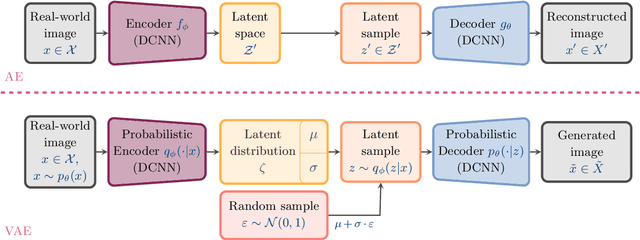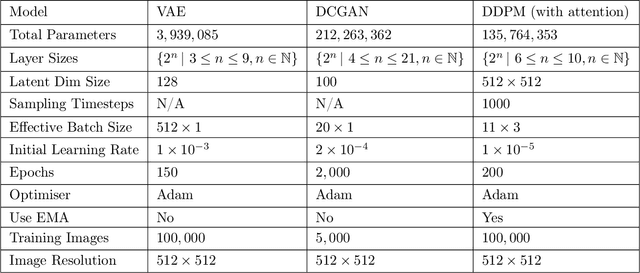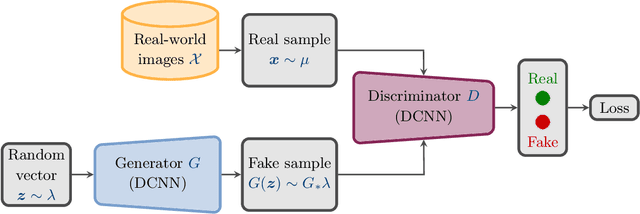Claudia Drygala
Learning Brenier Potentials with Convex Generative Adversarial Neural Networks
Apr 28, 2025Abstract:Brenier proved that under certain conditions on a source and a target probability measure there exists a strictly convex function such that its gradient is a transport map from the source to the target distribution. This function is called the Brenier potential. Furthermore, detailed information on the H\"older regularity of the Brenier potential is available. In this work we develop the statistical learning theory of generative adversarial neural networks that learn the Brenier potential. As by the transformation of densities formula, the density of the generated measure depends on the second derivative of the Brenier potential, we develop the universal approximation theory of ReCU networks with cubic activation $\mathtt{ReCU}(x)=\max\{0,x\}^3$ that combines the favorable approximation properties of H\"older functions with a Lipschitz continuous density. In order to assure the convexity of such general networks, we introduce an adversarial training procedure for a potential function represented by the ReCU networks that combines the classical discriminator cross entropy loss with a penalty term that enforces (strict) convexity. We give a detailed decomposition of learning errors and show that for a suitable high penalty parameter all networks chosen in the adversarial min-max optimization problem are strictly convex. This is further exploited to prove the consistency of the learning procedure for (slowly) expanding network capacity. We also implement the described learning algorithm and apply it to a number of standard test cases from Gaussian mixture to image data as target distributions. As predicted in theory, we observe that the convexity loss becomes inactive during the training process and the potentials represented by the neural networks have learned convexity.
Comparison of Generative Learning Methods for Turbulence Modeling
Nov 25, 2024



Abstract:Numerical simulations of turbulent flows present significant challenges in fluid dynamics due to their complexity and high computational cost. High resolution techniques such as Direct Numerical Simulation (DNS) and Large Eddy Simulation (LES) are generally not computationally affordable, particularly for technologically relevant problems. Recent advances in machine learning, specifically in generative probabilistic models, offer promising alternatives for turbulence modeling. This paper investigates the application of three generative models - Variational Autoencoders (VAE), Deep Convolutional Generative Adversarial Networks (DCGAN), and Denoising Diffusion Probabilistic Models (DDPM) - in simulating a 2D K\'arm\'an vortex street around a fixed cylinder. Training data was obtained by means of LES. We evaluate each model's ability to capture the statistical properties and spatial structures of the turbulent flow. Our results demonstrate that DDPM and DCGAN effectively replicate the flow distribution, highlighting their potential as efficient and accurate tools for turbulence modeling. We find a strong argument for DCGAN, as although they are more difficult to train (due to problems such as mode collapse), they gave the fastest inference and training time, require less data to train compared to VAE and DDPM, and provide the results most closely aligned with the input stream. In contrast, VAE train quickly (and can generate samples quickly) but do not produce adequate results, and DDPM, whilst effective, is significantly slower at both inference and training time.
Generalization capabilities of conditional GAN for turbulent flow under changes of geometry
Feb 20, 2023Abstract:Turbulent flow consists of structures with a wide range of spatial and temporal scales which are hard to resolve numerically. Classical numerical methods as the Large Eddy Simulation (LES) are able to capture fine details of turbulent structures but come at high computational cost. Applying generative adversarial networks (GAN) for the synthetic modeling of turbulence is a mathematically well-founded approach to overcome this issue. In this work, we investigate the generalization capabilites of GAN-based synthetic turbulence generators when geometrical changes occur in the flow configuration (e.g. aerodynamic geometric optimization of structures such as airfoils). As training data, we use the flow around a low-pressure turbine (LPT) stator with periodic wake impact obtained from highly resolved LES. To simulate the flow around a LPT stator, we use the conditional deep convolutional GAN framework pix2pixHD conditioned on the position of a rotating wake in front of the stator. For the generalization experiments we exclude images of wake positions located at certain regions from the training data and use the unseen data for testing. We show the abilities and limits of generalization for the conditional GAN by extending the regions of the extracted wake positions successively. Finally, we evaluate the statistical properties of the synthesized flow field by comparison with the corresponding LES results.
Generative Modeling of Turbulence
Dec 05, 2021



Abstract:We present a mathematically well founded approach for the synthetic modeling of turbulent flows using generative adversarial networks (GAN). Based on the analysis of chaotic, deterministic systems in terms of ergodicity, we outline a mathematical proof that GAN can actually learn to sample state snapshots form the invariant measure of the chaotic system. Based on this analysis, we study a hierarchy of chaotic systems starting with the Lorenz attractor and then carry on to the modeling of turbulent flows with GAN. As training data, we use fields of velocity fluctuations obtained from large eddy simulations (LES). Two architectures are investigated in detail: we use a deep, convolutional GAN (DCGAN) to synthesise the turbulent flow around a cylinder. We furthermore simulate the flow around a low pressure turbine stator using the pix2pixHD architecture for a conditional DCGAN being conditioned on the position of a rotating wake in front of the stator. The settings of adversarial training and the effects of using specific GAN architectures are explained. We thereby show that GAN are efficient in simulating turbulence in technically challenging flow problems on the basis of a moderate amount of training date. GAN training and inference times significantly fall short when compared with classical numerical methods, in particular LES, while still providing turbulent flows in high resolution.
Background-Foreground Segmentation for Interior Sensing in Automotive Industry
Sep 20, 2021



Abstract:To ensure safety in automated driving, the correct perception of the situation inside the car is as important as its environment. Thus, seat occupancy detection and classification of detected instances play an important role in interior sensing. By the knowledge of the seat occupancy status, it is possible to, e.g., automate the airbag deployment control. Furthermore, the presence of a driver, which is necessary for partially automated driving cars at the automation levels two to four can be verified. In this work, we compare different statistical methods from the field of image segmentation to approach the problem of background-foreground segmentation in camera based interior sensing. In the recent years, several methods based on different techniques have been developed and applied to images or videos from different applications. The peculiarity of the given scenarios of interior sensing is, that the foreground instances and the background both contain static as well as dynamic elements. In data considered in this work, even the camera position is not completely fixed. We review and benchmark three different methods ranging, i.e., Gaussian Mixture Models (GMM), Morphological Snakes and a deep neural network, namely a Mask R-CNN. In particular, the limitations of the classical methods, GMM and Morphological Snakes, for interior sensing are shown. Furthermore, it turns, that it is possible to overcome these limitations by deep learning, e.g.\ using a Mask R-CNN. Although only a small amount of ground truth data was available for training, we enabled the Mask R-CNN to produce high quality background-foreground masks via transfer learning. Moreover, we demonstrate that certain augmentation as well as pre- and post-processing methods further enhance the performance of the investigated methods.
 Add to Chrome
Add to Chrome Add to Firefox
Add to Firefox Add to Edge
Add to Edge